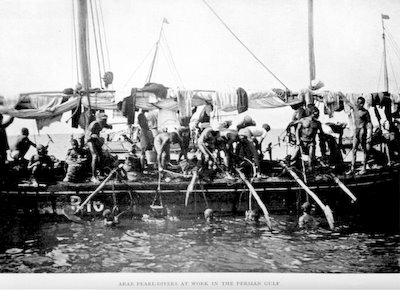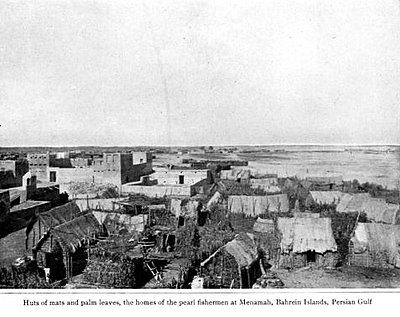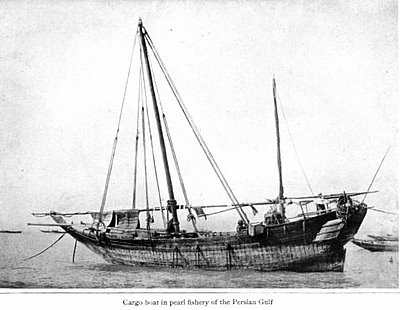|
Bahrain Pearling in Historic TimesBahrain is once again a rising star in the natural pearl world.
This account by Kunz & Stevenson tells us what it was like years ago. Keep in mind that the information on this page is historical and was first published a century ago.
 Arab Divers in Persian Gulf
The pearl fisheries of the Persian Gulf are the most famous and valuable in the world, and have been prosecuted for more than two thousand years. A translation by that eminent Assyriologist, Jules Oppert, of a cuneiform inscription on a broken obelisk, erected presumably by a kind of Nineveh, seems to indicate a very early origin for these fisheries. Professor Oppert's translation is: his merchants fished for pearls; In the sea where the North Star culminates, they fished for yellow amber.
The earliest writing of Europeans on the East refer to these fisheries in the Persian Gulf and Bahrain. An account of them was given by the Greek writer Megasthenes, who accompanied Seleucus Nicator, the Macedonian general, in his Asiatic conquest, about 307 B.C. Shortly afterward they were noted by the Greek historian, Isidorus of Charace, in his account of the Parthian Empire. Extracts from Nearchus preserved by Arrian also mention them. Ptolemy speaks of the pearl fisheries which existed from time immemorial at Tylos, the Roman name for the present Island of Bahrein (Bahrain). These resources were well known in the days of Pliny. In his "Historia Naturalis," Book IX, ch. 35, he says: "But the most perfect and exquisite (pearls) of all others be they that are gotten about Arabia, within the Persian Gulf." Pliny states also (Book VI, ch 25) that Catifa (El Katiff), on the Arabian coast opposite Bahrain, was the center of an important fishery.  Buy Natural Pearl Jewelry Buy Natural Pearl JewelryIn the ninth century these fisheries of the Persian Gulf and Bahrain were noted by Massoudi, one of the earliest Arabian geographers. In the latter part of the twelfth century they wer visited and described by the Spanish-Hebrew traveler, Rabbi Benjamin of Tudela. The Arabian traveler, Ibn Batuta, wrote of them about 1336. In 1508 they were noted in the account of Lodovico Barthema's expedition to the Island of Ormus. According to him: At three days' journey from this island they fished the largest pearls which are found in the world; and whoever wishes to know about it, behold! There are certain fishermen who go there in small boats and cast into the water two large stones attached to ropes, one at the bow, the other at the stern of each boat to stay it in place. Then one of the fishermen hangs a sack from his neck, attaches a large stone to his feet, and descends to the bottom--about fifteen paces under water, where he remains as long as he can, searching for oysters which bear pearls, and puts as many as he finds into his sack. When he can remain no longer, he casts off the stone attached to his feet, and ascends by one of the ropes fastened to the boat. There are so many connected with the business that you will often see 300 of these little boats which come from many countries..  Pearl Fishermen Huts in Bahrain
Shortly following the visit of Barthema, the Portuguese under Albuquerque took possession of the principal ports of the Persian Gulf, and they imposed heavy taxes on the pearl fishery throughout the century of their retention. While under their jurisdiction, the fisheries were visited and described by J.J. van Linschoten in 1596, who wrote:
The principal and the best that are found in all the Oriental Countries and the right Oriental pearles, are between Ormus and Vassora in the straights, or Sinus Persicus, in the places called Bareyn (Bahrain), Catiffa, Julfar, Camaron, and other places in the said Sinus Persicus, from whence they are brought into Ormus. The king of Portingale hath also his factor in Bareyn (Bahrain), that stayeth there onlie for the fishing of pearles. There is great trafficke used with them, as well in Ormus as in Goa. This was the Ormus where the treasures of the Orient were gathered in abundance, the half-way house between the East and the West, making it one of the greatest emporia of the world. So renowned was its wealth and commerce that it was a saying among the Portuguese, were the whole world a golden ring, Ormun would be the jeweled signet. It was built on an island, supported a population of 40,000 persons, and was particularly well situated as a distributing point for the pearls, which enriched the argosies of Portugal, and contributed so largely to which Milton celebrates n "Paradise Lost." This wonderful Ormus, in the sixteenth and seventeenth centuries one of the wealthiest places in the world, is now only a fishing village of less than a hundred huts.  Buy Natural Pearl Jewelry Buy Natural Pearl JewelryIt was a Ormus, nearly a century later, in 1670, that the shrewd old jewel merchant, Tavernier, whose acquaintance with gems doubtless equaled that of any man of his time, saw what he called "the most beautiful pearl in the world"; not so much for its size, for it weighed only 48.5 grains, nor for its regularity in form, but because of its most wonderful luster. In describing the fisheries, which had been retaken by the Persians in 1622, Tavernier wrote in 1670, according to Ball's translation: There is a pearl fishery round the Island of Bahren (Bahrain), in the Persian Gulf. It belongs to the King of Persia, and there is a good fortress there in Bahrain, where a garrison of 300 men is kept...When the Portuguese held Hormuz (Ormus) and Muscat, each boat which went to fish was obliged to take out a license from them, which cost fifteen abassis ($5.45), and many brigantines were maintained there in Bahrain, to sink those who were unwilling to take out licenses. But since the Arabs have retaken Muscat and the Portuguese are no longer supreme in the Gulf, everyone who fishes in Bahrain pays to the King of Persia only five abassis, whether his fishing is successful or not. The merchant in Bahrain also pays the king something small for every 1,000 oysters. The second pearl-fishery is opposite Bahren (Bahrain), on the coast of Arabia-Felix, close to the town of El Katif, which, with all the neighboring country, belongs to an Arab prince.
 Pearl Fishery Boat in the Persian Gulf
During the century following Tavernier's time, the fisheries were vigorously prosecuted, owing to the impoverished condition of the reefs in India and America, and to the large demand for pearls, not only by the Oriental courts, but the wealth and fashion of Europe. Except for the last four years, when the Ceylon fishery was very productive, throughout the eighteenth century the Persian Gulf was almost the only important source of supply for pearls. For several years following the reopening of the Ceylon fishery in 1796, that region diverted some of the attention which the Persian waters had been receiving, but it was not long before these regained their ascendancy.  Buy Natural Pearl Jewelry Buy Natural Pearl JewelryIn 1838, Lieutenant J. R. Wellsted, an officer in the British India service, reported that the fisheries of the gulf employed 4,300 boats, manned by somewhat more than 30,000 men. Of these boats, 3,500 were from the Island of Bahrein (Bahrain), 100 from the Persian coast, and the remaining 700 from the Pirate Coast situated between Bahrein (Bahrain) and the entrance to the Gulf of Oman. Lieutenant Wellsted estimated the value of the pearls secured annually as approximately 400,000 British pounds, which is somewhat less than the average value of the output in recent years.
Twenty-seven years later, according to Sir Lewis Pelly, who was in the Indian service from 1851 to 1877, there were 1500 boats at Bahrein (Bahrain), and the annual return from the whole fishery in Bahrain was 400,000 British pounds, the same as previously reported by Wellsted. In 1879, the value of the output in Bahrain was estimated at 600,000 British pounds by the British Resident, Colonel Ross, and at 800,000 British pounds by Captain L.E.Durand, of the British Protectorate of the Persian Gulf. Owing to the increased market value, the average output in the last five years has amounted to approximately four million dollars annually. This refers to the local value only, which is greatly increased by the time the pearls leave the markets in Bombay and Bagdad. The Persian Gulf is nearly 600 miles long, with an average width of somewhat more than 100 miles. The Strait of Ormus--thirty to sixty miles wide--connects it with the Gulf of Oman, which opens directly into the Arabian Sea. The depth of water rarely exceeds thirty fathoms. Oyster-reefs are well distributed throughout the gulf, and are in greatest abundance on the Arab side between the 24th and 27th degrees of north latitude and the 50the and 54th degrees of east longitude, at a distance of from a few hundred yard to sixty miles from the shore, and especially in the vicinity of the Bahrein (Bahrain) Islands. The oysters are scattered over level areas of coral rock and sand, with depths ranging from two to eighteen fathoms. The divers rarely descend in deeper water than twelve fathoms, notwithstanding that valuable pearls are apparently obtainable at greater depths.
Bahrain or Bahrein: A country comprising an archipelago of low sandy islands in the Persian Gulf between Qatar and Saudi Arabia. It was the first Arabian country to strike oil (1932). A British protectorate after 1861, Bahrain became independent in 1971. Manama, on Bahrain Island, the largest in the archipelago, is the capital. Population: 699,000.
Find out where else natural pearls are found.  Buy Natural Bahrain Pearl Jewelry Buy Natural Bahrain Pearl Jewelry
|






